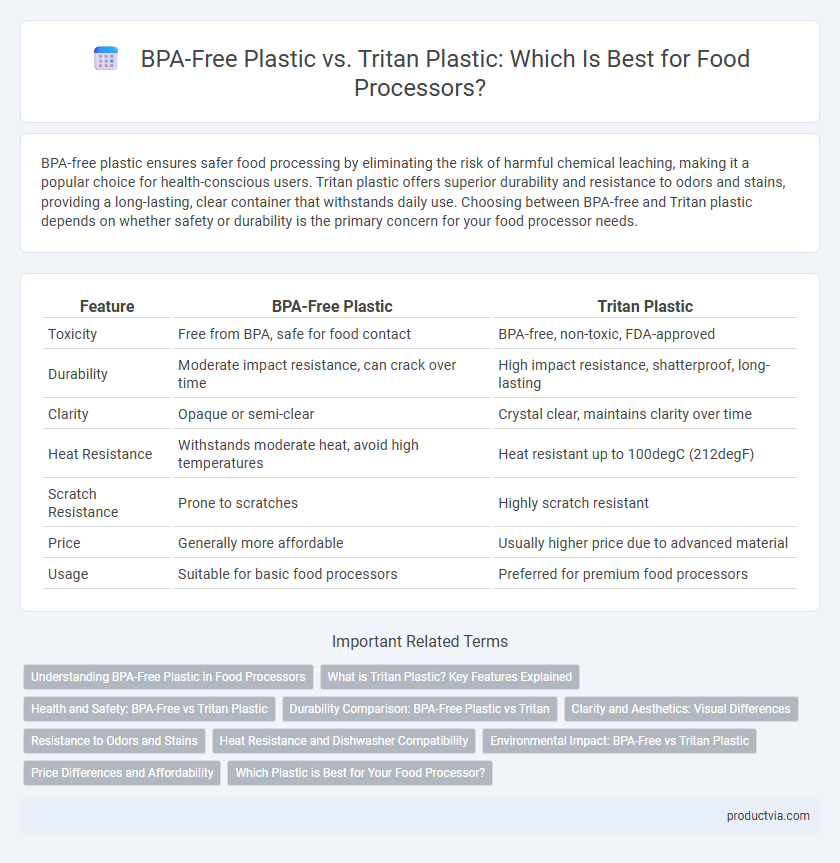BPA-free plastic ensures safer food processing by eliminating the risk of harmful chemical leaching, making it a popular choice for health-conscious users. Tritan plastic offers superior durability and resistance to odors and stains, providing a long-lasting, clear container that withstands daily use. Choosing between BPA-free and Tritan plastic depends on whether safety or durability is the primary concern for your food processor needs.
Table of Comparison
| Feature | BPA-Free Plastic | Tritan Plastic |
|---|---|---|
| Toxicity | Free from BPA, safe for food contact | BPA-free, non-toxic, FDA-approved |
| Durability | Moderate impact resistance, can crack over time | High impact resistance, shatterproof, long-lasting |
| Clarity | Opaque or semi-clear | Crystal clear, maintains clarity over time |
| Heat Resistance | Withstands moderate heat, avoid high temperatures | Heat resistant up to 100degC (212degF) |
| Scratch Resistance | Prone to scratches | Highly scratch resistant |
| Price | Generally more affordable | Usually higher price due to advanced material |
| Usage | Suitable for basic food processors | Preferred for premium food processors |
Understanding BPA-Free Plastic in Food Processors
BPA-free plastic in food processors eliminates bisphenol A, a chemical linked to health risks, ensuring safer food preparation. This plastic is designed to prevent harmful chemical leaching when processing hot or acidic foods. Choosing BPA-free materials prioritizes user health while maintaining durability and heat resistance essential for efficient food processing.
What is Tritan Plastic? Key Features Explained
Tritan plastic is a BPA-free, durable, and impact-resistant material commonly used in food processors for enhanced safety and longevity. It offers excellent clarity, heat resistance, and dishwasher-safe properties, ensuring no harmful chemicals leach into food during processing. Unlike traditional BPA-free plastics, Tritan maintains its strength and transparency over time, making it a preferred choice for high-quality kitchen appliances.
Health and Safety: BPA-Free vs Tritan Plastic
BPA-free plastic in food processors ensures the absence of bisphenol A, a chemical linked to hormonal disruptions, promoting safer food handling. Tritan plastic is a BPA-free alternative known for high durability and resistance to odors and stains, making it a safer and more hygienic choice for long-term use. Choosing Tritan or certified BPA-free materials reduces the risk of harmful chemical leaching, protecting health during food preparation.
Durability Comparison: BPA-Free Plastic vs Tritan
Tritan plastic offers superior durability compared to BPA-free plastic, with enhanced resistance to impact, scratching, and heat, making it ideal for heavy-duty food processor use. BPA-free plastics may degrade faster under intense and prolonged use, potentially leading to cracks or warping over time. Choosing Tritan ensures a longer lifespan and consistent performance in food processing appliances.
Clarity and Aesthetics: Visual Differences
BPA-free plastic in food processors offers a slightly cloudy or matte finish, which can obscure the view of ingredients but ensures safety from harmful chemicals. Tritan plastic provides superior clarity with a crystal-clear, glass-like appearance that enhances aesthetics and allows users to easily monitor food processing. The visual transparency of Tritan not only improves kitchen elegance but also helps in precise food preparation by giving a clear view of the contents.
Resistance to Odors and Stains
BPA-free plastic used in food processors offers basic resistance to odors and stains but may absorb strong food smells over time, leading to discoloration. Tritan plastic provides superior resistance to odors and stains due to its non-porous surface and chemical stability, maintaining clarity and hygiene with frequent use. Choosing Tritan plastic enhances durability and preserves the appliance's appearance and cleanliness, especially with foods prone to leaving strong residues.
Heat Resistance and Dishwasher Compatibility
BPA-free plastic used in food processors typically offers moderate heat resistance, suitable for everyday kitchen tasks but may warp under prolonged exposure to high dishwasher temperatures. Tritan plastic stands out with superior heat resistance, maintaining durability and clarity even after repeated dishwasher cycles, making it ideal for high-temperature cleaning. Choosing Tritan plastic ensures enhanced longevity and safety for food processors subjected to frequent dishwasher use and heat exposure.
Environmental Impact: BPA-Free vs Tritan Plastic
BPA-free plastics reduce health risks by eliminating bisphenol A, but often come from conventional plastics with limited biodegradability and recycling challenges. Tritan plastic is a durable, BPA-free copolyester that offers higher strength and resistance to wear, increasing the product lifespan and reducing waste frequency. Environmentally, Tritan's recyclability and durability present a more sustainable option compared to many BPA-free plastics, which may rely on less eco-friendly materials.
Price Differences and Affordability
BPA-free plastic food processors generally come at a lower price point, making them more affordable for budget-conscious buyers seeking safe materials. Tritan plastic offers superior durability and chemical resistance but typically commands a higher cost due to its advanced properties. Consumers must weigh the initial investment against long-term durability when choosing between BPA-free and Tritan food processor plastics.
Which Plastic is Best for Your Food Processor?
BPA-free plastic ensures safety by eliminating harmful Bisphenol A chemicals, making it a reliable choice for health-conscious consumers using food processors. Tritan plastic offers superior durability, resistance to odors, and clarity, enhancing the longevity and aesthetic appeal of food processor components. Choosing between BPA-free and Tritan plastics depends on prioritizing chemical safety versus high-performance durability in your food processor.
BPA-free plastic vs Tritan plastic for food processor Infographic

 productvia.com
productvia.com